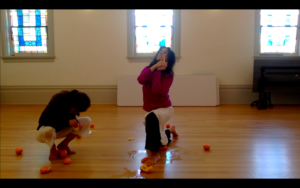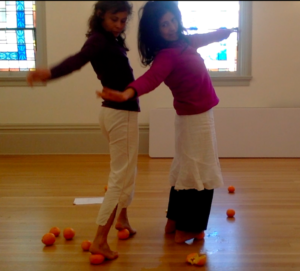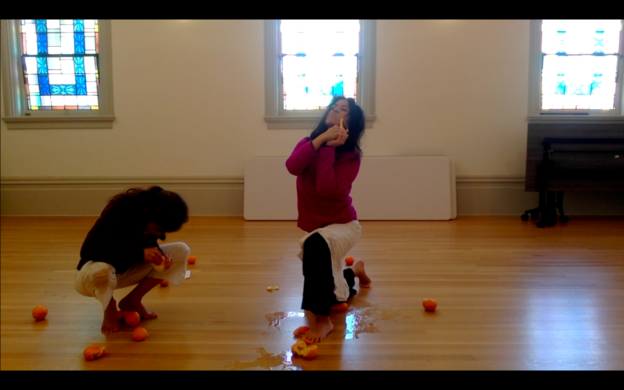
I am remembering my dad when he left me in the parking lot of Tegucigalpa’s tiny airport when I was 14 years old, and he said “always remember your country.” I honestly forgot my country and my family –consciously and unconsciously – while I was living in Mexico. My father died almost 20 years ago, and my mother two years ago. Now that both are gone, I just cannot stop thinking about my country. It is like the mother land is calling me and supporting me in the absence of my parents.
I am a migrant and an artist like many others in this country. I have migrated multiple times, since I left Honduras, the country where I was born. I started my performance-choreography career in Mexico, yet while I was there, I never felt compelled to reflect, write or create dance pieces about my identity as a migrant or as Honduran. Maybe youth and survival mode masked the symptoms of “cultural shock,” and made me numb to the disadvantages of being Honduran and the discrimination I faced based on my origin, gender, and spoken accent.
Every migration began by seeing myself in opposition to the dominant culture. It didn’t matter if I was arriving to a new country, or a country where I’d lived before, there has always been an “I am not like you” phase within a rocky transition. After nine years living in Mexico, I returned to Honduras, and to my surprise, I was totally unprepared to fit into Honduran culture. I was robbed and touched by men in the street multiple times. My senses did not read danger, and my reflexes could not act to protect me. After two years, I returned to Mexico City, I broke into tears in my ride from the Mexico City airport to the apartment where I would live for the next two years. Looking out through the window I felt totally unprepared to deal with the immensity of that noisy city. My best friend who picked me up from the airport asked me why I was speaking so slowly, and I noticed that she was speaking very fast. We had been living in cultures that move at different paces.
When I relocated from Mexico City to San Francisco nine years ago, I felt that somebody was scolding me all the time. Then I realized that I was not used to seeing written rules around me telling me the right way to do things. I didn’t know if I should laugh or take seriously the “watch your step” sign in the MUNI bus. Since my English was deficient at that time, I felt that I should try to understand every sign or otherwise I would break an important rule or miss some important information. After a few months, I relaxed into the normality of public display of warnings.

Migrating as an adolescent is not the same as when you are an adult. Everybody knows that. But more importantly, it is different to migrate when you have more awareness and somatic training in your body. My body told me every day how different San Francisco was from Mexico City. First, I realized how heavy the doors were and that I needed more strength in my upper body to open them. Second, my ears felt clean and open with an authentic desire to hear after being retracted for about twenty years in the noisy Mexico City. In those first years in San Francisco, it was refreshing to feel universal, and to have the possibility to reinvent and expand my heritage, my story, myself.
Then, I began managing a research project that involved Latinas who had to fill out surveys with questions about race and ethnicity, generation, language of preference, and other indicators to measure acculturation. Many women chose to mark the “other” option and wrote down the name of their countries in the blank space. Was that an indication of rejection of those artificial categories? or was that a way to reinforce their uniqueness? I wondered what option would have felt more accurate for myself. Maybe “none of the above.”
With all these questions in mind, I felt this huge and growing need of making dance pieces about classification, identity, fragmentation, immigration, and grieving from faraway. That is what I have been doing in the San Francisco Bay Area, with the support and collaboration of artists Joy Cosculluela, Rosemary Hannon, Joyce Lu, Christine Germain, Bonner Odel, Aya Chigusa, Kim Campisano, , Liz Boubion, and John Rodgers, among others. I feel embraced and inspired by many other artists in the US who have paved the way for this inquiry. This never-ending exploration that makes life so rich and empty. This never-ending need for an anchor, and a ground to hold the heaviness of our hearts. This joy for all the experiences and souls that we encountered here and there. This joy for this universal breath, for the support of millions of cells, for the possibility of dissolving and creating again.
Last fall, I embarked on a new project with Philippine migrant choreographer Joy Cosculluela. We both have been reflecting on our identity as immigrant choreographers, performers, and somatic practitioners in the US. Discerning what we are here and now, brought us to the cultures in which we grew up. In specific, we have been reflecting on our common catholic upbringing and schooling in our Spanish-colonized countries. Although our countries of origin are geographically apart, they are very close in the dominance that catholic church exerts on the society, the lack of choices to study outside of catholic schools, and the pervasive stigma for those who do not follow catholic rituals. We both have a shared experience of those who were educated in catholic schools, a common guilt and shame, a common tolerance for sacrifice, a common desire of wanting to be “good” and accepted even at the cost of betraying ourselves.

In the studio, and in conversations at cafes, Joy and I have been exploring the different ways in which we continue carrying the weight of catholicism in our body, and we have been trying strategies to peel away the layers of guilt, and shame through writing, reading, interacting with objects, and of course dancing, and improvising. We have concluded that the antidote for shame and guilt is in fact to pray for its disappearance. Something like homeopathic medicine principles: like cures like. So, we are creating the antidote pray-ritual, expressing it in movement and stillness, articulating its content and rhythm, hoping to bring healing to ourselves, and to those who have had similar experiences. We are in the process of creating a new form of praying in which we peel oranges with hands, peelers, knives; we roll, kneel, balance and smash the oranges; we peel the skin to discover the bones, and to recognize the faces that were buried somewhere.
Through this process, I am questioning why it is valued to be “good,” and why undervalued to be real, and live true. I am calling my land, my parents, and grandparents to bring acceptance and protection, while I discover who I am without those layers of guilt and shame. I am remembering and honoring the support that my parents gave me to believe or not in catholicism or in any other religion. I am embodying a pray-ritual that culminates with the statement being “good” is OVERrated.
This article appeared in the January/February 2018 edition of In Dance.


